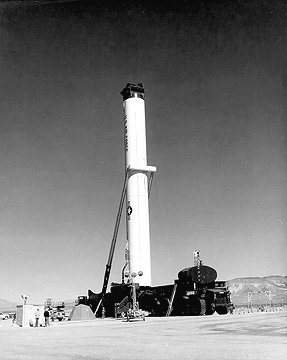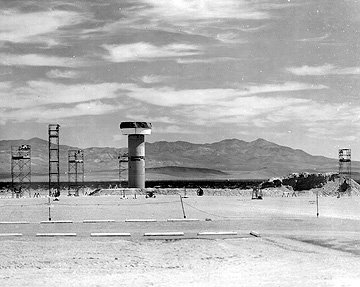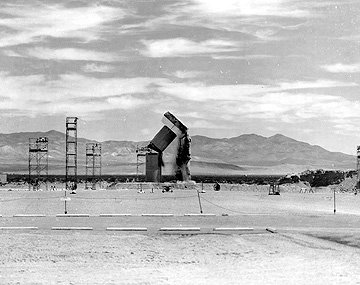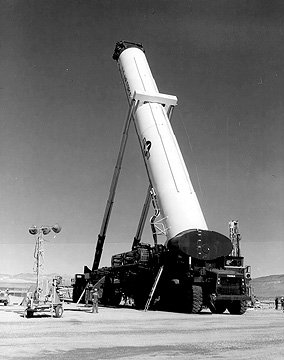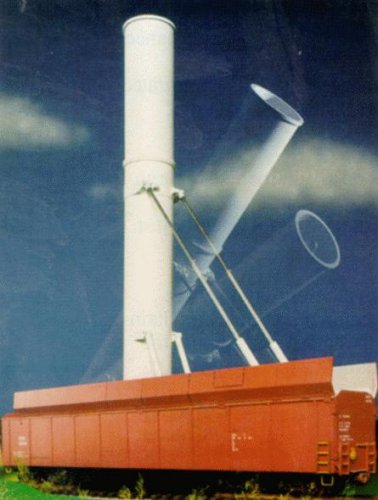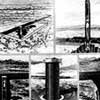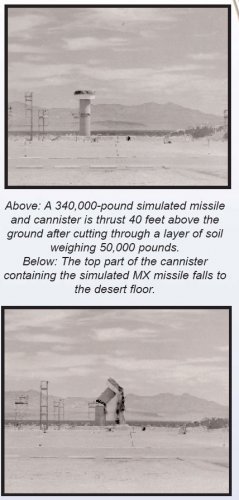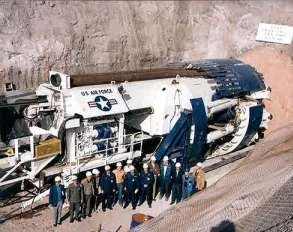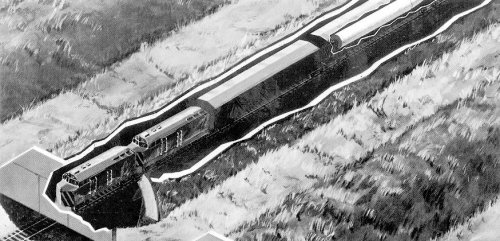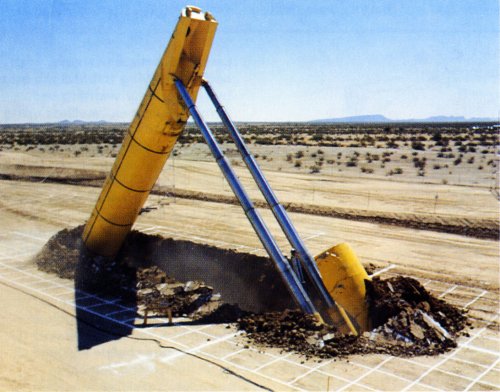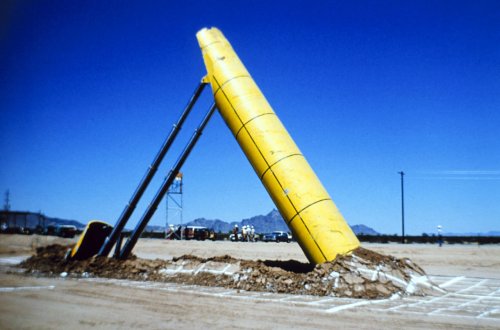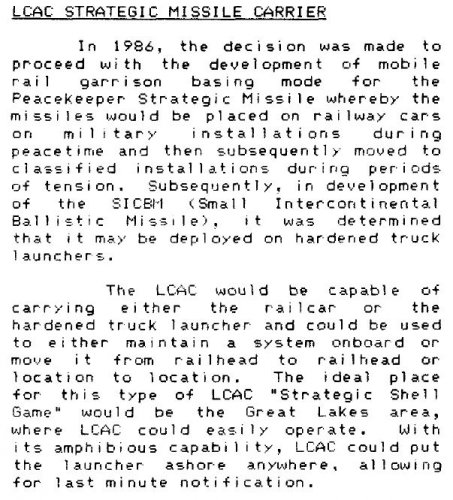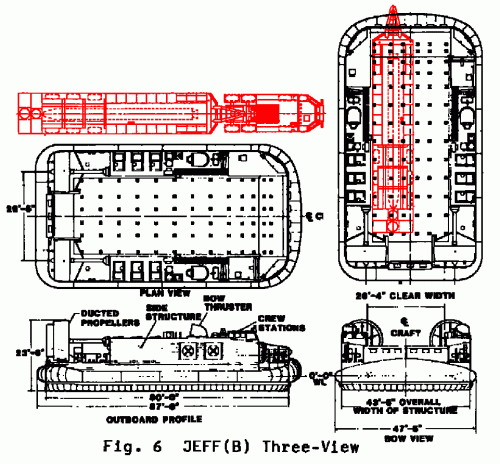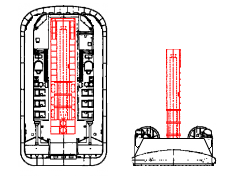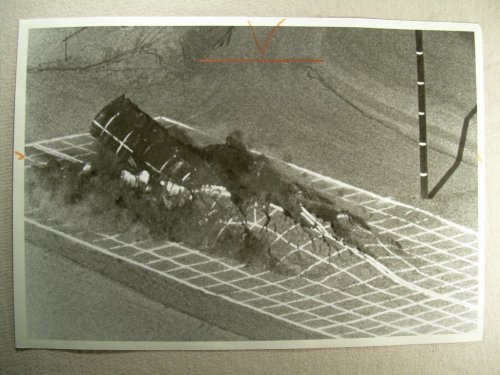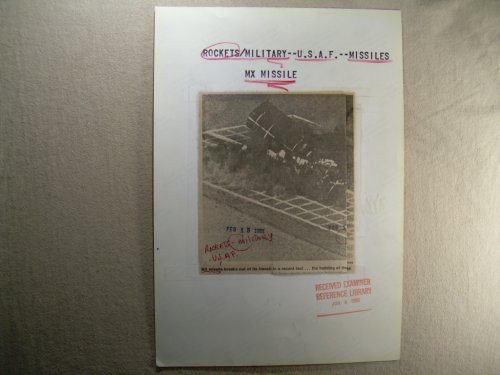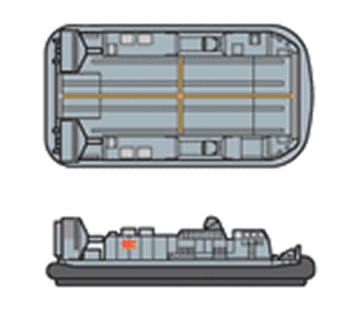- Joined
- 3 June 2011
- Messages
- 18,344
- Reaction score
- 12,259
Numerous methods of deploying the Peacekeeper were investigated and I wish somebody had all the details. Here's a few things I turned up:
"One of the first MX projects was the Vertical Shelter Ground System Definition Program which required
construction of an 18-foot diameter, 130-foot deep vertical silo for missile loading and egress (exit)
tests.
The egress mechanism was built to thrust a 348,000-pound simulated missile and canister out of the
silo to a height of 40 feet above ground after it burst through a 50,000-pound layer of soil."
"Extensive prototype tests were conducted at the U.S. Army Engineer Waterways Experiment Station to adapt Corps of Engineers (CE) flexible pavement design criteria to pavements to be used in the MX missile program. The initial shell game concept for dispersing the MX missiles required construction of approximately 8,000 miles of roads capable of sustaining numerous passes of a missile transporter weighing about 1,500,000 lb. This research resulted in increased knowledge of the performance of pavements subjected to heavy loads. Prototype test sections of bituminous surface-treated roads and gravel-surfaced roads were designed and constructed using current CE criteria. The test sections were trafficked to the design number of operations using a trafficking rig simulating the MX missile transporter. The trafficking rig was equipped with two load tires in line, each approximately 8 ft tall by 3 ft wide, inflated to 65 psi, and having a loaded weight of 62,500 lb. Test traffic was placed on the pavement and conditions were monitored for pavement distress. Analysis of the resulting test data led to the connclusion that existing CE criteria can be modified to provide a more economical pavement than was previously expected for very heavy loads. Most distress appeared in the form of deeper consolidation caused by the very heavy loads on the unusually large tires. Other load parameters such as contact area and contact pressure were in more typical ranges and, therefore, gave more typical results. (Author)"
There were a LOT of different methods investigated. One would have them in a long concrete tunnel maybe ten feet under the ground and if the alarm came hydraulic rams would raise the canister into position shoving aside the concrete roof and overlying dirt in the process. I remember seeing footage of this test on the news back in the day and it was pretty impressive.
Another was the shell game. Imagine each missile deployed on a "racetrack" with 23 hardened shelters dispersed around it and a giant transporter shuffling a missile between them randomly. If it got caught in the open it would simply raise the missile and fire it. If not, it would back up to the front of the shelter like a semi backing up to a loading dock and the canister would be "fed" into the shelter. Each shelter could also raise the canister into position and fire the missile.
"Case Against the MX, a Shell Game That Could Misfire; MX: Prescription for Disaster, by Dr. Herbert Scoville Jr. Cambridge: The MIT Press. $6.95 (paperback)
By Burke Wilkinson
In the jaunty jargon of Armageddon, the delivery vehicle for the hotly debated MX missile is called "the bus," and the independently targetable missiles themselves are the "passengers." In the same ghoulish lexicon, the cluster of 23 shelters that would conceal one live and mobile missile is the "race course."
On the drawing board, the race course is being supplanted by a series of clusters (hardened silos) in line ahead, connected by straight roads. But the nightmarish shell game remains the same. The Soviets must guess which silo contains the live missile. In order to be absolutely sure that they knock it out, they would have to saturate all 23 clusters in the area.
The size and cost of the project -- approved in principle during the Carter administration -- are staggering. The number of proposed cluster areas is 200. They would require 50,000 square miles in Utah and Nevada, a slice of America the size of Alabama. Cost as of today's fast escalating estimate: $120 billion. "
Another was the "super hard silo". From what I recall they tested silos that could withstand up to 50,000 psi (today's are about 2,000 psi). There was a photo in Airforce Magazine back in the day of one of the tests. There was a huge crater in the ground and there sticking up in the middle of it was the concrete silo unscratched.
Don't remember exactly what they were using the tunnel machine for but it was in the mix somewhere too.
There was also the rail garrison (which had previously been kicked around for the Minuteman)
"One of the first MX projects was the Vertical Shelter Ground System Definition Program which required
construction of an 18-foot diameter, 130-foot deep vertical silo for missile loading and egress (exit)
tests.
The egress mechanism was built to thrust a 348,000-pound simulated missile and canister out of the
silo to a height of 40 feet above ground after it burst through a 50,000-pound layer of soil."
"Extensive prototype tests were conducted at the U.S. Army Engineer Waterways Experiment Station to adapt Corps of Engineers (CE) flexible pavement design criteria to pavements to be used in the MX missile program. The initial shell game concept for dispersing the MX missiles required construction of approximately 8,000 miles of roads capable of sustaining numerous passes of a missile transporter weighing about 1,500,000 lb. This research resulted in increased knowledge of the performance of pavements subjected to heavy loads. Prototype test sections of bituminous surface-treated roads and gravel-surfaced roads were designed and constructed using current CE criteria. The test sections were trafficked to the design number of operations using a trafficking rig simulating the MX missile transporter. The trafficking rig was equipped with two load tires in line, each approximately 8 ft tall by 3 ft wide, inflated to 65 psi, and having a loaded weight of 62,500 lb. Test traffic was placed on the pavement and conditions were monitored for pavement distress. Analysis of the resulting test data led to the connclusion that existing CE criteria can be modified to provide a more economical pavement than was previously expected for very heavy loads. Most distress appeared in the form of deeper consolidation caused by the very heavy loads on the unusually large tires. Other load parameters such as contact area and contact pressure were in more typical ranges and, therefore, gave more typical results. (Author)"
There were a LOT of different methods investigated. One would have them in a long concrete tunnel maybe ten feet under the ground and if the alarm came hydraulic rams would raise the canister into position shoving aside the concrete roof and overlying dirt in the process. I remember seeing footage of this test on the news back in the day and it was pretty impressive.
Another was the shell game. Imagine each missile deployed on a "racetrack" with 23 hardened shelters dispersed around it and a giant transporter shuffling a missile between them randomly. If it got caught in the open it would simply raise the missile and fire it. If not, it would back up to the front of the shelter like a semi backing up to a loading dock and the canister would be "fed" into the shelter. Each shelter could also raise the canister into position and fire the missile.
"Case Against the MX, a Shell Game That Could Misfire; MX: Prescription for Disaster, by Dr. Herbert Scoville Jr. Cambridge: The MIT Press. $6.95 (paperback)
By Burke Wilkinson
In the jaunty jargon of Armageddon, the delivery vehicle for the hotly debated MX missile is called "the bus," and the independently targetable missiles themselves are the "passengers." In the same ghoulish lexicon, the cluster of 23 shelters that would conceal one live and mobile missile is the "race course."
On the drawing board, the race course is being supplanted by a series of clusters (hardened silos) in line ahead, connected by straight roads. But the nightmarish shell game remains the same. The Soviets must guess which silo contains the live missile. In order to be absolutely sure that they knock it out, they would have to saturate all 23 clusters in the area.
The size and cost of the project -- approved in principle during the Carter administration -- are staggering. The number of proposed cluster areas is 200. They would require 50,000 square miles in Utah and Nevada, a slice of America the size of Alabama. Cost as of today's fast escalating estimate: $120 billion. "
Another was the "super hard silo". From what I recall they tested silos that could withstand up to 50,000 psi (today's are about 2,000 psi). There was a photo in Airforce Magazine back in the day of one of the tests. There was a huge crater in the ground and there sticking up in the middle of it was the concrete silo unscratched.
Don't remember exactly what they were using the tunnel machine for but it was in the mix somewhere too.
There was also the rail garrison (which had previously been kicked around for the Minuteman)

